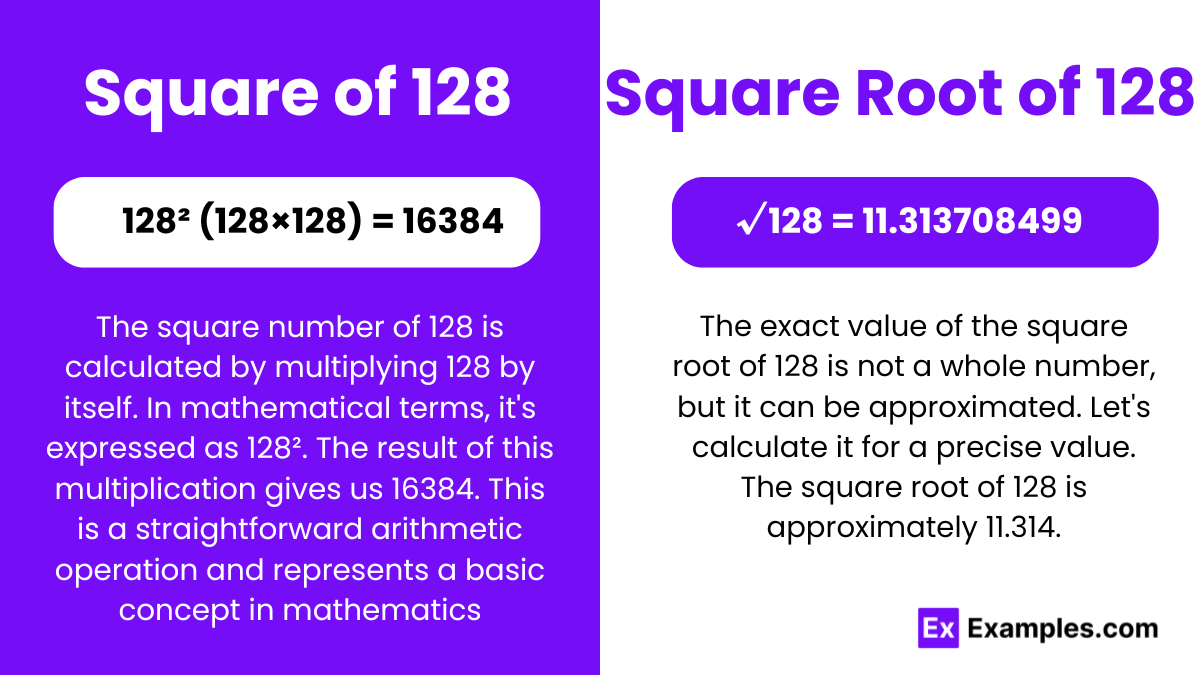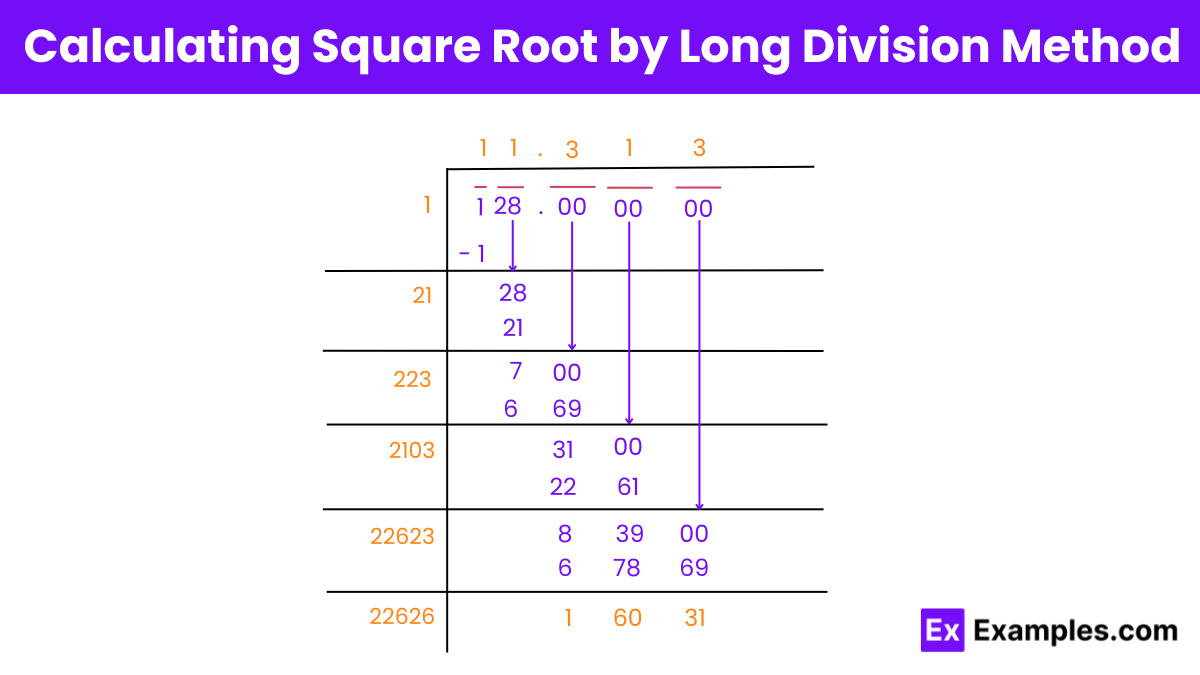What is the square of 128?
16,384
15,384
17,064
18,064

The square number of 128 is calculated by multiplying 128 by itself. In mathematical terms, it’s expressed as 128². The result of this multiplication gives us 16384. This is a straightforward arithmetic operation and represents a basic concept in mathematics, where squaring a number means raising it to the power of two.
√128 = 11.313708499
Or
√128 = 11.313 up to three places of decimal
The exact value of the square root of 128 is not a whole number, but it can be approximated. Let’s calculate it for a precise value.
The square root of 128 is approximately 11.314. This value is often used in mathematical calculations where you need to determine a number that, when squared, produces 128.
Square Root of 128: 11.313708499
Exponential Form: 128^1/2 or 128^0.5
Radical Form: √128
A number is considered irrational if it cannot be expressed as a simple fraction where both the numerator and the denominator are integers. In the case of √128, the value is a non-repeating, non-terminating decimal, which cannot be precisely represented as a fraction of two integers.
Rational numbers are those that can be expressed as the quotient of two integers, where the numerator and the denominator are both integers, and importantly, the denominator is not zero. This allows rational numbers to be written as fractions.
Examples: 3/2,5/4
Irrational numbers are those which cannot be expressed as a ratio of two integers. They have decimal expansions that are infinite and non-repeating, distinguishing them clearly from rational numbers. Irrational numbers frequently occur in various mathematical contexts such as geometry and algebra.
Examples: π,√2
Estimation:
You can start by identifying the perfect squares that are closest to 128, which are 121 (11^2) and 144 (12^2).
Since 128 is closer to 121, you can estimate that the square root of 128 is slightly more than 11.
Long Division Method:
This is a manual method similar to traditional long division but adapted for finding square roots. It involves guessing and refining those guesses through a process of division and averaging.
Begin with an approximate value (e.g., 11), divide 128 by this number, and average the result with the original guess to get a closer approximation.
Using a Calculator:
The simplest and most accurate method for most purposes is to use a calculator. Most calculators have a square root function.
Newton’s Method (Numerical Method):
This is a more advanced technique used for finding increasingly accurate approximations of the roots of real-valued functions.
It starts with a guess and iteratively refines this guess using the formula:
xₙ₊₁ =xₙ− f(xₙ)/f′(xₙ), where f(x)=x² − 128 for finding the square root of 128.
Exponential and Logarithmic Functions:
Using properties of exponents and logarithms, you can find square roots by transforming the operation into an exponentiation:
√128=128¹/².
This can be calculated using the exponential and logarithmic functions either on a scientific calculator or using software that handles complex arithmetic.

Start by writing the number: Express 128 as 128.000000, adding zeros for precision, and place a bar over the number, grouping from right to left, starting with 128.
Initial division:
Divide the first pair (1 in this case) by a number whose square is less than or equal to 1. Here, 1×1 = 1.
The quotient is 1 and the remainder is 0.
Second step:
Double the quotient (now 2). This becomes part of your new divisor.
Bring down the next pair (28), making the new dividend 28.
Find a digit (let’s say ‘1’) such that (20 + 1) × 1 = 21, which is less than 28.
Update the result:
Subtract 21 from 28 to get a remainder of 7.
The updated quotient is now 11.
Third step:
Double the latest quotient to get 22.
Bring down the next group of zeros, so your new dividend is 700.
Choose a new number (3 in this case) so that (220 + 3) × 3 = 669, which is under 700.
Refine the quotient:
Subtract 669 from 700 to get a remainder of 31.
Incorporate the result into the quotient, refining it to 11.3.
Continue refining:
Repeat the process, doubling the latest quotient, bringing down more pairs of zeros, and finding new numbers until the quotient stabilizes or reaches the desired precision (three decimal places in this case).
Result:
The approximate value of the square root of 128 is 11.313 after refining the quotient through successive steps.
No, A perfect square is a number that can be expressed as the square of an integer. For example, 121 is a perfect square because it can be written as 11².
To check if 128 is a perfect square, you can try finding an integer whose square equals 128. Since the squares of 11 and 12 are 121 and 144, respectively, and 128 falls between these two values, it indicates that there is no integer whose square equals 128. Therefore, 128 is not a perfect square.
To find this, you look for the largest square number that is a factor of 128. The factors of 128 include 1, 2, 4, 8, 16, 32, 64, and 128. Out of these, 64 (which is 8²) is the largest perfect square.
The factors of 128, which are numbers that can divide 128 without leaving a remainder, are 1, 2, 4, 8, 16, 32, 64, and 128.
The numbers 128 is divisible by are its factors: 1, 2, 4, 8, 16, 32, 64, and 128.
Yes, 128 is a composite number. A composite number is a positive integer greater than 1 that has more than two positive divisors. In the case of 128, it has divisors other than 1 and itself. For example, it can be divided evenly by 2, 4, 8, 16, 32, 64, and 128. Therefore, 128 is a composite number.
Text prompt
Add Tone
10 Examples of Public speaking
20 Examples of Gas lighting
What is the square of 128?
16,384
15,384
17,064
18,064
Which of the following is the square root of 128?
10.5
11.3
11.31
12.4
If x² = 128, what is x?
11
12
12.8
11.31
What is the value of 128 squared plus 128 itself?
16,512
16,384
16,256
16,128
The square root of 128 is closest to which integer?
10
11
12
13
Which of the following equations is true for the square of 128?
128² = 16,000
128² = 16,384
128² = 15,000
128² = 16,500
What is the difference between the square of 128 and the square root of 128?
16,373
16,384
16,372
16,365
What is 128 raised to the power of 0.5?
11.31
12
128
64
If 128 = a², what is aaa when simplified?
12
8√2
16
11.31
What is the result when the square of the square root of 128 is subtracted from 128?
0
128
128 - 11.31
128 - 128
Before you leave, take our quick quiz to enhance your learning!

